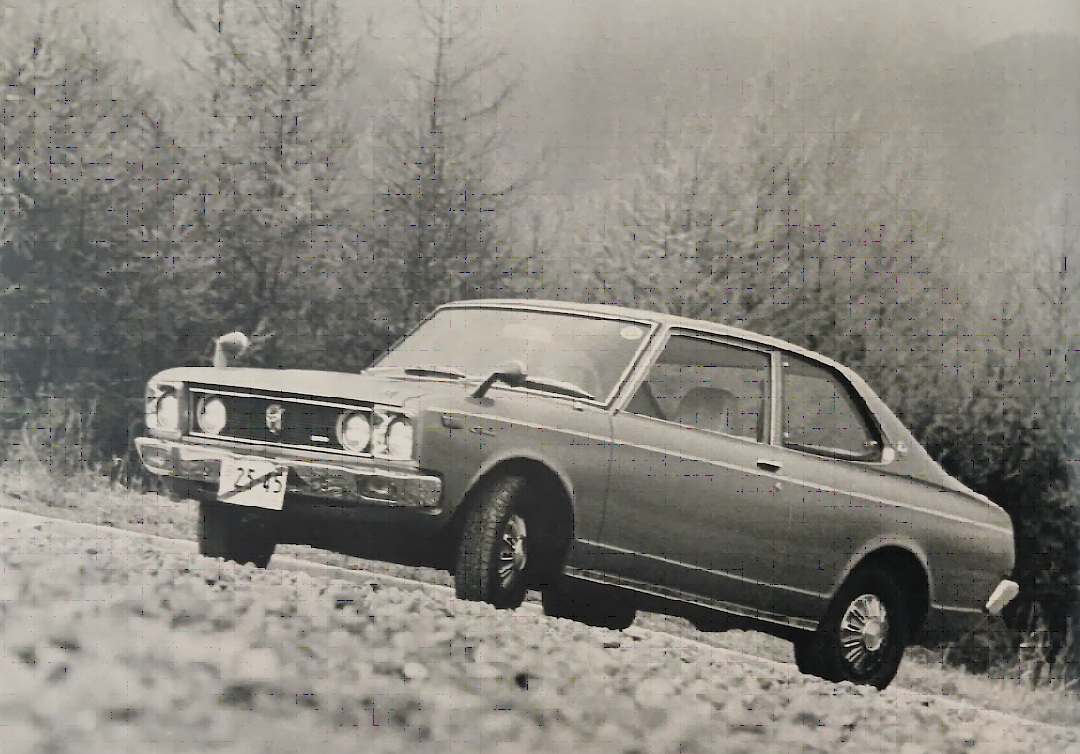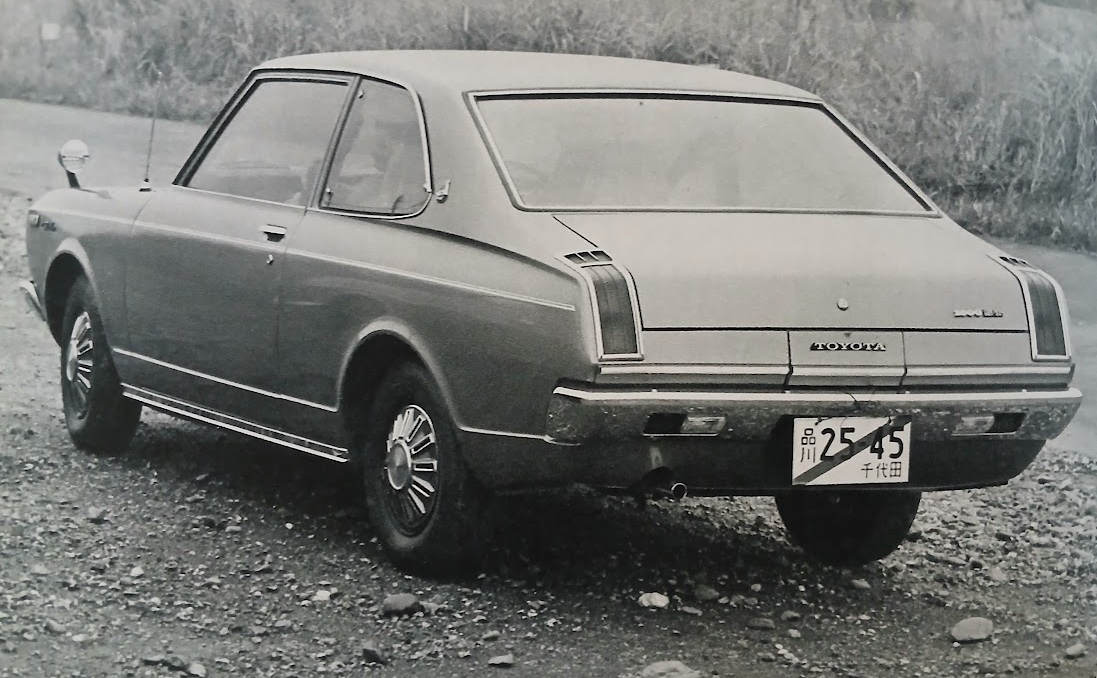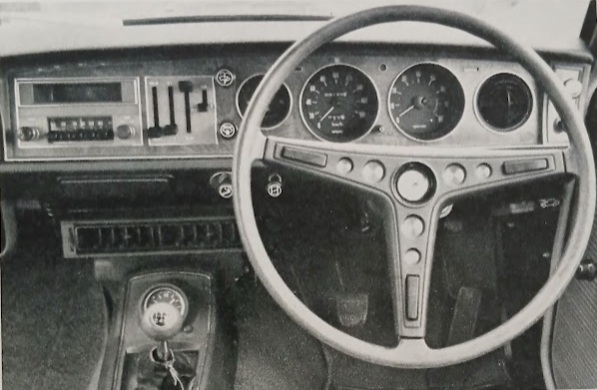Toyota Carina 1600ST (1971)

Publication: Car Graphic
Format: Road Test
Date: January 1971
Author: “C/G Test Group” (uncredited)
Road testing the Toyota Carina 1600ST
The Toyota Carina (advertised featuring the character, “Karina”), first unveiled to the public at the Tokyo Motor Show in the fall of 1970 and released on December 1st, is a five-seat semi-fastback sedan with exterior dimensions closer to that of the Corona 1500/1700 than the Corolla. It is powered by three engines: the same 1407cc 86p OHV with crossflow head that powers the Corolla 1400, a 1588cc, 100ps unit with enlarged bore, and a 105ps twin-carburetor version. A wide variety of transmissions is available, including a 3-speed column shift, 4-speed floor shift, and even a 5-speed option on the 1600cc model, a major attraction of the Carina. The suspension is different from any previous model. While the front suspension uses conventional MacPherson struts, the rear suspension is essentially the same as the Crown, a rigid axle suspended with a four-link and Panhard rod system and supported by coil springs. The body is available in two-door and four-door versions, with prices ranging from 509,000 yen for the 1400 Standard with 3-speed column shift, to 720,000 yen for the 1600ST four-door with twin carburetors and 5-speed.
We conducted a short 300km road test drive, including some basic instrumented tests at the Murayama Test Course, in the most powerful Carina model, the 1600ST (Sports Touring) two-door with a 5-speed gearbox (TA12-MS, priced at 700,000 yen). A quick glance at the specs revealed nothing particularly noteworthy, except for the 5-speed gearbox. Seeing the car in person, we were, as always, impressed by the incredibly well-finished and equipped interior for the price point, typical of Toyotas. However, we were pleasantly surprised immediately upon starting the car: the Carina possesses many qualities we’ve never found in any other Toyota before. In short, the Carina speaks to its driver in the same idiom as the finest European sports sedans.
First, the driving position is near ideal, thanks to the breathable vinyl high-back bucket seats which provide just the right amount of support, and the steering wheel, gear lever, and pedals are all perfectly sized and angled relative to one another, at least for my body type. Visibility is excellent, and the standard three-point seat belts are retractable, with pockets and hooks for storing the belts and their respective anchors when not in use. (In cars without these, insensitive rear passengers often step on them when you try to wear them.)
As soon as I turned the first street corner, I immediately noticed that the steering was unusually accurate for a Toyota. It’s not particularly sharp, but the overall steering system is very rigid. A common problem with all Toyotas (and most Japanese-made cars in general) is the sluggish, almost rubbery response when first starting to turn the wheel from the straight-ahead position. This trait alone would put me off buying a car, but the Carina has none of this. The test car was fitted with 165SR-13 Bridgestone Radial 10 tires (optional), which, as I’ll explain later, greatly contributed to the car’s handling.
Even during my slow-speed driving around Tokyo on the way to the Murayama Test Course, the 1.6-liter 105ps OHV engine felt both extremely powerful and exceptionally flexible at low speeds. Of course, I didn’t have a chance to use the overdrive fifth gear, but the direct fourth gear allowed me to maintain a steady speed even at 30km/h (about 1100rpm), and it accelerated easily from 1500rpm onwards. My first full-throttle run in each gear at Murayama revealed that, despite being a brand-new car, the engine revved smoothly all the way up to the redline of over 6500rpm, and the balancing was exceptionally good. Mechanical noise is low, but it’s a shame that the exhaust system starts to resonate in the cabin around 2500-3000rpm. This is something that could be easily solved by something as simple as thickening the tailpipe or modifying its body-mounting bracket.
The main attraction of the Carina is its excellent 5-speed gearbox. The gear ratios are close, similar to those of the Alfa 1300GT, one of Europe’s most beloved sports sedans (incidentally, during a later interview, I got the impression that Chief Designer Nishida is quite fond of Alfas). The overall gear ratios are just right for the car’s 910kg weight, peak output of 105ps/6000rpm, and 14.0kgm of torque. Revved up to the 6500rpm redline, it easily reaches speeds of 48, 85, and 124km/h in first, second, and third gears (all calculated values; the speedometer shows approximately 52, 90, and 130km/h, respectively), before smoothly shifting up. The gearshift is light and precise, although the synchronization is not particularly powerful.
Acceleration is extremely quick; at Murayama, we measured a 0-400m time of 17.9 seconds, finishing the run in third gear. This was achieved on my third attempt, and I was still not fully accustomed to the car. Unfortunately, shortly after this, the clutch would not disengage at all, forcing us to temporarily halt the tests. Investigation revealed that all the oil had leaked from the clutch slave cylinder. We towed the car to a nearby dealer with the C/G Capella and had it checked, and it was discovered that the air bleed valve had come loose. We topped it off with oil and bled the air, and were able to continue with the testing.
The unexpected clutch repair used up a lot of time, and it was past 1:30pm by the time we were able to resume testing. We decided to make good use of the remaining five hours until the evening, when we were due to return the car, by going on a high-speed tour along the Chuo Expressway, Kawaguchiko, Hakone, Odawara, Atsugi and the Tomei Expressway. Cruising at high speed on the Chuo Expressway, we immediately noticed how well the car responded in top gear, and how high-geared it was for a 1600cc.
The engine responds extremely well over a wide range of speeds in fourth gear, from 2000 to 5500rpm (50 to 150km/h), and reacts immediately to throttle inputs. You can also engage overdrive fifth gear at speeds above 60km/h, and it responds quite well above 3000rpm. While this might suggest the gear ratios are low, this is actually not the case, as fourth gear gives 26.3km/h per 1000rpm, while fifth gear gives 30.5km/h, slightly higher than that of the Alfa 1600S (109ps, 1020kg, 24.1km/h and 30.4km/h per 1000rpm in fourth and fifth gears, respectively).
Although the Carina’s overall weight is not particularly light, the engine pulls effortlessly in these relatively high fourth and fifth gears, boasting exceptional torque characteristics. An actual speed of 100km/h (the speedometer reads about 6% fast) corresponds to about 3800rpm in fourth gear, at which speed the exhaust system resonance disappears, allowing for truly quiet cruising. Shifting up to fifth drops the revs to about 3300rpm, making the car even quieter. While the gear whine from an overdrive fifth gear often cancels out the reduction in engine noise (the old Toyota 1600GT was an example of this), in the Carina, gear noise is well-subdued in all ratios.
The top speed listed in the catalog is 175km/h, which corresponds to 5700rpm in fifth gear. However, this is likely either a calculated value or an experimental result recorded under “laboratory” conditions. Based on our experience that day, the top speed is likely closer to 170km/h, achievable in both fourth and fifth gears. If I were to take the Carina to Europe, I would be able to naturally push it up to about 150km/h in fourth gear (which is quite easy to achieve), then cruise with the engine revs lower in fifth gear, using fourth gear to regain speed when I needed more power to overtake or climb hills. I’m sure it would be able to compete on equal terms with a BMW 1600ti or an Alfa 1300.
The noise level at high speeds is very low due to the excellent balancing of the drivetrain and the low amount of wind noise around the windows (the most noticeable sound is that of the interior air being sucked out through the ventilation system). Straight-line stability is outstanding (there was almost no wind during our testing) and you only need to hold the steering wheel lightly to maintain course.
The Carina’s suspension, combined with the Bridgestone Radial 10 tires, is also unusually firm for a Toyota. In fact, the suspension is exceptionally firm for a pure family sedan from any domestic manufacturer, which is another quality more typical of Alfas. However, it is by no means harsh, and both bouncing and pitching are well-suppressed, providing a firm yet comfortable ride. The Bridgestone Radial 10 tires are on the stiffer side for domestic radials, so even in the Carina, they pick up some of the road’s irregularities. However, the fact that you only hear the kickback from the road surface, rather than feeling it in your hands, is proof that the suspension has plenty of compliance.
As the sun set, we descended from Lake Yamanaka over Kagosaka Pass to Gotemba, and by the time we arrived at the drive-in where we usually pit during tests and enjoy Russian tea, the early winter darkness had enveloped the area, and cold rain had begun falling. On the climb up Otome Pass, we were able to experience a glimpse of the Carina’s cornering capabilities. The rear axle, positioned with coils, four links and a Panhard rod, combined with the Bridgestone Radial 10s, provided such good grip on the mountain pass that even when powering around a hairpin using full throttle in second gear, there was no trace of sliding. The cornering power of the front wheels was well balanced with that of the rear wheels, and understeer was very mild, with only slight squealing from the tires except in extreme cases. While I’d like to refrain from making any definitive statements based on this limited experience, I can at least say that compared to cars I’ve driven on the same course, the Carina felt faster than a Fiat 124S and roughly on par with an Alfa 1750. What I also reaffirmed on this hill climb was the immense power of the transmission’s third gear.
The servo-equipped disc/drum brakes provided consistent performance at all speeds. There was little nose dive, and pedal pressure, despite the servo, was appropriately heavy, which is actually quite desirable.
Driving through mountain passes at night, I noticed that the headlights were particularly dim. Also, the control knobs, especially for the wipers, were too far away from a natural driving position. Incidentally, as I pointed out last month with the Publica SL, most recent Toyota vehicles have placed the four-way flasher switch in a location where it is easily confused with the headlight switch. Recently, there’s been a nationwide trend of people flashing their four-way flashers as soon as they enter a tunnel, and I worry that Toyota’s control placement will further exacerbate this dangerous trend. Since these warning lights should only be used when the vehicle is stopped, it’s best to position it out of easy reach while driving.
Finally, regarding fuel economy, we drove a total of 301km (corrected for the odometer which read 2.1% over) at a significant pace to return the car to Toyota Motor Sales at the appointed time, and the average was unexpectedly good, consuming 31 liters of high-octane gasoline and averaging 9.7km/l.
In conclusion, the Carina was the first Toyota car I have driven that was more captivating for its driving performance than for its high-quality appearance.
Postscript: Story Photos





